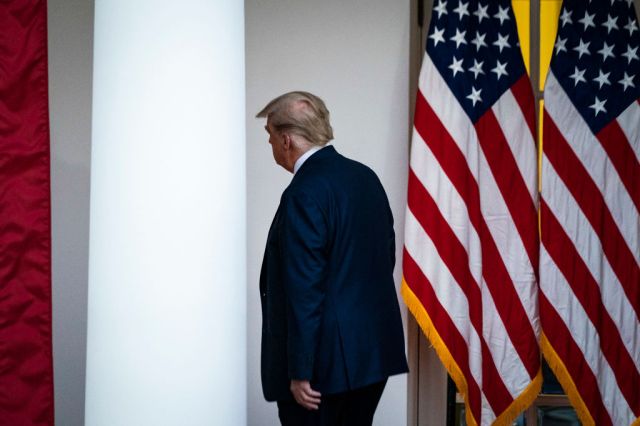Have we seen the last of President Donald J. Trump? Credit: Jabin Botsford/The Washington Post via Getty

Donald Trump is leaving the White House, Dominic Cummings has left No 10 Downing Street and populists around the world are in decline. Cue the return of the debate that we have every year or so: is the party all over for populism?
“Does Trump’s defeat signal the start of populism’s decline?”, asks the New York Times. “A Biden win buries the populist decade,” states The Article. “Its best days may already be over”, suggests The Guardian. “After four years of President Trump, and four years of trying to get Brexit done”, writes Andy Beckett, “populism is entering a trickier political stage: middle age”.
Populism has had a terrible year. The highs of 2016 feel like a very long time ago. Contrary to the old saying that you need a crisis to put anti-establishment revolts on steroids, this crisis seems to be throwing cold water over them.
Compare the polls before the pandemic erupted, in January, and how they look today. In Italy, Matteo Salvini’s League is down from 30 to 25%. In France, Marine Le Pen’s movement had a disappointing set of local elections earlier this year, losing around 40% of her local officials. In Germany, the Alternative for Germany is down from 14 to 9%, and the mainstream centre-Right and centre-Left that are up. In Brazil, public disapproval of Jair Bolsonaro’s presidency more than doubled during the height of the crisis. And here in the United Kingdom, for those who see Boris Johnson as part of the same anti-establishment wave (I do not), he has lost a 20-point lead in the polls in less than a year.
Then come the latest findings from the YouGov-Cambridge Globalism Project, a survey of about 26,000 people across 25 countries, which suggests that ‘populist tendencies’ among people in Europe are in decline. And to this we might add the coming shift in political debates more generally.
We might have a vaccine but we also have the largest pile of debt since the Second World War. Somebody still needs to pay for this crisis. And that means that debates over economics, things like taxation and redistribution, which underpin the traditional ‘Left versus Right’ spectrum, have by no means disappeared. The 2010s were dominated by debates over identity and culture but the 2020s may soon see a return to those classic debates over the economy, so the thinking goes. And that might help the Left.
Look ahead, as I suggested in June, and it is not hard to see a chain of potential events that could utterly transform the global debate. Joe Biden enters the White House in January, the Alternative for Germany slump at elections in Germany a few months later, Emmanuel Macron is comfortably re-elected in 2022, Bolsonaro is kicked out in 2022, Poland’s Law and Justice lose in 2023 and a Labour-SNP coalition take power here in the UK.
One of the big arguments about national populism is that it represents a values-based backlash among a loose alliance of blue-collar workers and middle-class conservatives against the excesses of liberalism. Were that chain of events to take place then, so the thinking goes, it would represent a counter-backlash by a loose alliance of liberal graduates, ethnic minorities, Millennials and Zoomers — a newly ascendant majority who reflect how demography is, ultimately, destiny.
It’s all so seductive, isn’t it? Only, I don’t really buy it. The rise, nature and appeal of populism have always been more complicated than our public debates would have us believe. There is even a serious debate to be had about whether you can even ‘get rid’ of populism, or whether that would even be desirable. Democracy ultimately depends on the people for its legitimacy and, going back to Michael Oakeshott, has long incubated a tradition that sees politics not simply as process and management, but as a forum through which the people can search for national redemption, salvation and renewal.
Populism is something that kicks in when our democracies become too remote and detached from the people. Not only is it impossible to strip this long tradition out, but even if we could then we would find ourselves confronted with the very opposite of democracy: hollow, distant, bureaucratic and soulless technocracies. Democracy has always rested on the uneasy balance between these two styles.
But looking past that, I think that in the current moment we can also see three more specific reasons why the populist challenge to what we might call the liberal mainstream is unlikely to disappear in the years ahead.
The first is one of the big lessons from the previous crisis, the Great Recession: political volatility lies downstream from crises. Had we tried to predict the political effects of the Great Recession during the eye of the storm, as Lehman Brothers fell, then it is very unlikely that we would have foreseen the full extent of the churn and change that was about to arrive: the rise of Trump, Brexit, Salvini, Le Pen and others, as well as the continued collapse of social democracy.
These revolts may not have been caused by the Great Recession, but they were certainly given a helping hand by that crisis. And the full impact wasn’t clear immediately. It was only years later, once its effects had bled into people’s daily lives, that the underlying divides began to find their expression in the world of politics.
It may well be the same this time around. Consider this study on the effect of past pandemics: SARS (2003), H1N1 (2009), MERS (2012), Ebola (2014) and Zika (2016). It finds that five years after the immediate impact, the ‘Gini coefficient’, the main measure of inequality, has increased significantly.
To that we might add the looming pile of evidence from around the world which shows, quite clearly, that it is low-income voters who have, once again, been hit disproportionately hard by both the health and economic fallout of coronavirus. We know, for example, that in the United States most of the job losses have hit lower-income groups; while here in the UK, the Office for National Statistics suggests it is working-class ‘elementary workers’ who have been most likely to suffer higher rates of unemployment and mortality during this crisis. This tells me that many of the underlying social divides that fed the higher rates of political volatility in 2010s are, if anything, only being reinforced by this crisis.
The second is that we now have growing evidence that demography might not be destiny. Trump might be on the way out but Trumpism is alive and well. Look at data on voting patterns in the United States and you can make a case for how, actually, his movement has broadened rather than narrowed.
As Michael Lind points out in UnHerd, one of the big political narratives about populism — that it is mainly a refuge for old white men — has imploded as Hispanic, Latino, Cuban American and women drifted toward the outgoing incumbent. Put simply, there was no major repudiation of Trumpism. There was no blue wave.
This is all consistent with what Roger Eatwell and I argued in National Populism. These movements have deep roots within our societies while their reach is potentially wider than many think. Significant numbers of ethnic minority voters (like the one in three black and ethnic minority Brexiteers), a good chunk of graduates, the self-employed and middle-class remain receptive to this politics.
In the same way, it is worth noting that significant numbers of people from LGBT communities in France support Marine Le Pen because of threats to their rights from Islamic extremists, while here in the UK Boris Johnson has shown that you can substantially realign a party electorate (a realignment that his new advisors would do well to study).
Liberal progressives have a habit of talking about politics as though it were a conveyor belt, with increasingly diverse populations gradually turning their way as one year follows the next. But look at the events of the past decade and ask yourself if you find this convincing. We’ve never had more graduates, liberals and middle-class professionals in our societies and yet the number of Left-wing parties that are in power has crashed while conservatives and populists have, on the whole, had some of their best years for decades.
The third and final reason is that I am still not convinced liberals have crafted a meaningful reply to the underlying grievances that led us here in the first place. Look at Biden’s campaign. He certainly did inch a little closer to Trump; his ‘Made in America’ tax incentive, penalty for offshoring and promise to review (rather than repeal) Trump’s tariffs on China all show how a protectionist spirit remains alive and well. Alongside his big promise to invest in manufacturing and infrastructure, this might explain why he did a little better among white men, even if these gains were not as impressive as we were told they would be.
But he said almost nothing about the cultural dimension. Early Biden executive orders will likely focus on cancelling funding for the wall, reversing the ‘Muslim travel ban’ and pushing softer immigration positions. These will go down well with his progressive base but they will also antagonise Republicans. So I see little reason to think that polarisation in America will reduce. One of the central challenges facing all of our leaders around the world is to somehow strike a compromise between these two camps. So far, few have found a way.
And what was Biden’s vision for a revitalised liberalism? It seems to me that his was a narrative that was more anti-Trump than pro-Biden, more anti-populist than pro-liberalism, if you like. In the same way, aside from managing coronavirus more effectively, what exactly is Keir Starmer’s vision for where he wants to take the country and the British people? We don’t really know because, so far, that vision does not seem to exist.
The year or two ahead may well be difficult ones for the populist Right which, as Beckett rightly notes, may find middle-age harder than adolescence. But we should not kid ourselves. Many of the underlying drivers are just as prominent as they were four years ago. Which means that the 2020s could end up being just as volatile as the 2010s.










Join the discussion
Join like minded readers that support our journalism by becoming a paid subscriber
To join the discussion in the comments, become a paid subscriber.
Join like minded readers that support our journalism, read unlimited articles and enjoy other subscriber-only benefits.
Subscribe